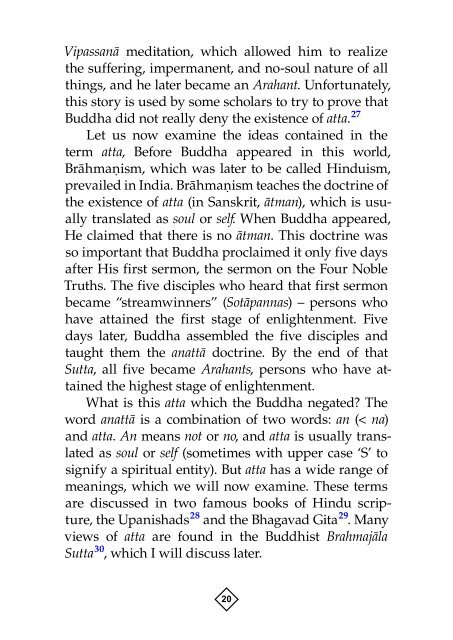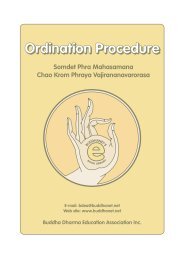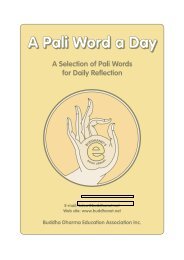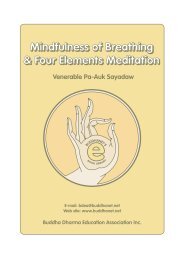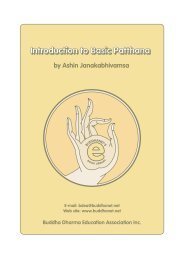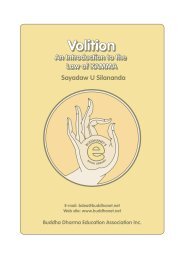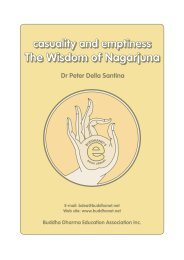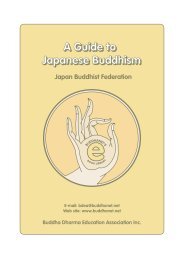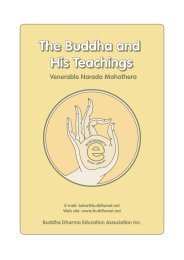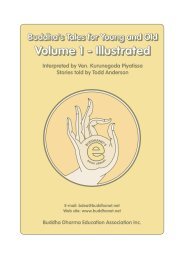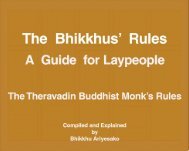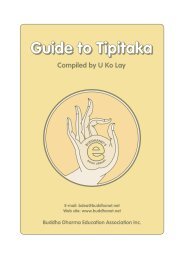No Inner Core: An Introduction to the Doctrine of Anatta - BuddhaNet
No Inner Core: An Introduction to the Doctrine of Anatta - BuddhaNet
No Inner Core: An Introduction to the Doctrine of Anatta - BuddhaNet
Create successful ePaper yourself
Turn your PDF publications into a flip-book with our unique Google optimized e-Paper software.
Vipassanà meditation, which allowed him <strong>to</strong> realize<br />
<strong>the</strong> suffering, impermanent, and no-soul nature <strong>of</strong> all<br />
things, and he later became an Arahant. Unfortunately,<br />
this s<strong>to</strong>ry is used by some scholars <strong>to</strong> try <strong>to</strong> prove that<br />
Buddha did not really deny <strong>the</strong> existence <strong>of</strong> atta. 27<br />
Let us now examine <strong>the</strong> ideas contained in <strong>the</strong><br />
term atta, Before Buddha appeared in this world,<br />
Bràhmaõism, which was later <strong>to</strong> be called Hinduism,<br />
prevailed in India. Bràhmaõism teaches <strong>the</strong> doctrine <strong>of</strong><br />
<strong>the</strong> existence <strong>of</strong> atta (in Sanskrit, àtman), which is usually<br />
translated as soul or self. When Buddha appeared,<br />
He claimed that <strong>the</strong>re is no àtman. This doctrine was<br />
so important that Buddha proclaimed it only five days<br />
after His first sermon, <strong>the</strong> sermon on <strong>the</strong> Four <strong>No</strong>ble<br />
Truths. The five disciples who heard that first sermon<br />
became “streamwinners” (Sotàpannas) – persons who<br />
have attained <strong>the</strong> first stage <strong>of</strong> enlightenment. Five<br />
days later, Buddha assembled <strong>the</strong> five disciples and<br />
taught <strong>the</strong>m <strong>the</strong> anattà doctrine. By <strong>the</strong> end <strong>of</strong> that<br />
Sutta, all five became Arahants, persons who have attained<br />
<strong>the</strong> highest stage <strong>of</strong> enlightenment.<br />
What is this atta which <strong>the</strong> Buddha negated? The<br />
word anattà is a combination <strong>of</strong> two words: an (< na)<br />
and atta. <strong>An</strong> means not or no, and atta is usually translated<br />
as soul or self (sometimes with upper case ‘S’ <strong>to</strong><br />
signify a spiritual entity). But atta has a wide range <strong>of</strong><br />
meanings, which we will now examine. These terms<br />
are discussed in two famous books <strong>of</strong> Hindu scripture,<br />
<strong>the</strong> Upanishads 28 and <strong>the</strong> Bhagavad Gita 29 . Many<br />
views <strong>of</strong> atta are found in <strong>the</strong> Buddhist Brahmajàla<br />
Sutta 30 , which I will discuss later.<br />
20


